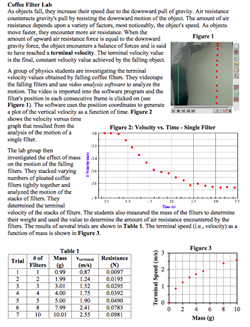 Coffee Filter Physics Lab
Coffee Filter Physics Lab
Resource:
Science Reasoning Center: Coffee Filter Physics Lab
Grade Level: High School
Description:
This passage describes a complex experiment that explores the changes in velocity over time for falling coffee filters. The effect of the number of filters upon the terminal speed is also investigated. Data is presented in the form of a diagram, two graphs and a data table. Questions target a student's ability to make meaning of written information, to select and interpret data presented in graphs and tables, and to identify conclusions that are consistent with experimental findings.
Performance Expectation:
HS-PS2-1: Analyze data to support the claim that Newton’s second law of motion describes the mathematical relationship among the net force on a macroscopic object, its mass, and its acceleration.
This activity aligns with the three dimensions of the Next Generation Science Standards in the manner described below:
| Force and Motion (HS-PS2.A.1): Newton's 2nd Law accurately predicts changes in the motion of macroscopic objects. |
As objects fall, they increase their speed due to the downward pull of gravity. When present, air resistance counteracts gravity's pull on falling objects. Newton’s 2nd Law can predict the acceleration of falling objects by considering both forces (gravity and air resistance) acting on the falling object. When the air resistance force is equal to the gravitational force, the object will no longer accelerate and will maintain a constant speed as it continues to fall. |
| Cause and Effect: Systems can be designed to cause a desired effect. |
This experiment investigates how the number of coffee filters (stacked inside one another) affects the terminal velocity of this falling system. As the reader will understand through his analysis, one can use this data to predict how the terminal velocity depends on the number of stacked filters. He may also begin to see that there are many applications—parachutes, for example—to this cause and effect relationship that can be engineered to create a desired effect. |
| Stability and Change: Change and rates of change can be quantified and modeled over very short or very long periods of time. Some system changes are irreversible. |
As Newton’s 2nd Law serves as a fundamental principle in predicting why objects change their velocity or not, this passage considers the motion of falling coffee filters in which initially unbalanced forces cause a change in motion that later leads to balanced forces causing them to fall with a constant speed. While not all systems seek equilibrium in such a short amount of time, this data passage is an example of simple physical system that does just that. |
| Analyzing and Interpreting Data: Analyze data using tools, technologies, and/or models (e.g., computational, mathematical) in order to make valid and reliable scientific claims or determine an optimal design solution. |
It is important that students are afforded the opportunity to use technologies and analysis tools as they study physical system. In this experiment, physics students use video analysis tools to capture a dot diagram of the falling filter system. Several questions at the end of the passage require students to analyze this collected data to make claims about a falling object’s terminal velocity. |
| Developing and Using Models: Develop or use a model based on evidence to illustrate the relationships between systems or between components of a system. |
As students are presented with several rich data presentations in the passage, they are asked to both use motion models as well as to develop their own model based on evidence to show that a relationship between variables must exist. Question 10 is a great example of how students can be asked to develop a model to illustrate a correlation between air resistance and terminal velocity from the given sets of data. |
| Engaging in Argument from Evidence: Make and defend a claim based on evidence about the natural world that reflects scientific knowledge, and student-generated evidence. |
While all physics students are asked to make claims about the physical world they are studying, it is important that they learn to support such claims with evidence and then provide reasoning that serves as the bridge to connect their claim and evidence. Questions 3, 4 and 7 at the end of this passage ask students to make such claims that must be supported with evidence collected experimentally. |
| Obtaining, Evaluating, and Communicating Information: Evaluate the validity and reliability of multiple claims that appear in scientific and technical texts or media reports, verifying the data when possible. |
Related to the skill of students being able to create their own evidence-based claims, is the need for students to use data to evaluate the claims of others. Questions 2, 6 and 9 at the close of this data presentation ask students to use evidence to evaluate the validity and reliability of claims presented. |
Associated Reading from The Physics Classroom
Other Supporting Pages at The Physics Classroom:
View Infographic.
(Coming Soon)
Search the NGSS Corner
Maybe you're looking for something really specific that pertains to a desired topic and emphasizes one or more of the listed NGSS dimensions. Why not try a search of this section of our website? Simply select from one or more of the pull-down menus and click Search This page will reload and a collection of possibilities will be displayed in this section of the page and sorted by relevancy.